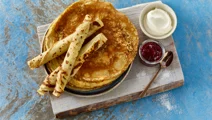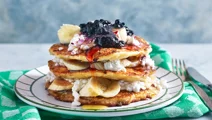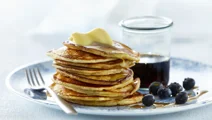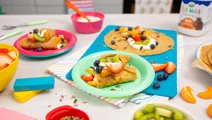Thai pancake with coconut and banana recipe
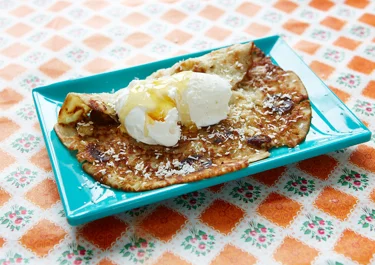
Discover the sweet and tropical flavours of Thai pancakes, where creamy coconut blends with the sweetness of bananas. This inviting recipe uses rice flour and coconut flakes for a light, fluffy texture with a golden, crispy finish. Perfect as a unique dessert or luxurious breakfast, these pancakes offer a delicious twist on traditional flavours. Enjoy them hot with a scoop of vanilla ice cream and a drizzle of light syrup for a true taste of Thailand in every bite.
Ingredients
|
Near-ripe bananas
|
2 |
|---|---|
|
Rice flour
|
135 g |
|
Flour
|
55 g |
|
Coconut flakes
|
25 g |
|
Coconut milk
|
165 ml |
|
Milk
|
250 ml |
|
Eggs
|
2 |
|
Salt
|
½ tsp |
|
Butter and rapeseed oil (for frying)
|
To serve
|
Vanilla ice cream
|
|
|---|---|
|
Light syrup
|
Instructions
Recommended information
Serving suggestion
Expert tips for thinly sliced bananas
Thinly slicing bananas involves both technique and the right tools. Start by peeling the banana and laying it on a cutting board. Using a sharp chef’s knife, cut it into thin slices, aiming for consistent thickness for even cooking and presentation. For optimal results, hold the banana with one hand and slice at a slight angle. This method increases the surface area of each slice, enhancing the texture and appearance of the pancakes. Alternatively, a mandolin slicer is an excellent tool for achieving perfectly thin and uniform slices. This method works particularly well with this recipe’s firm, near-ripe bananas, which are easier to handle. Always use the safety guard to protect your fingers. Once sliced, pat the banana pieces gently with kitchen paper to absorb any excess moisture, ensuring they caramelise beautifully when cooked.
Use more rice flour for extra crispy Thai pancakes
For an extra crispy texture, increasing the proportion of rice flour in the batter can make a big difference. Rice flour is naturally lighter and crispier than wheat flour, giving the pancakes a delicate crunch. Replace a portion of the wheat flour with additional rice flour to adjust the balance. Start by increasing the rice flour by about 25% (about 14 grams) and test the batter's consistency, ensuring it's still pourable but not too thin.
Master the frying technique
Start by preheating the pan over medium heat to ensure even cooking. Use a combination of butter and rapeseed oil for frying which prevents the butter from burning while adding a rich flavour. When pouring the batter into the pan, aim for a thin, even layer. Gently place the banana slices onto the batter immediately after pouring, ensuring they adhere as it cooks. Wait until the surface has set and the edges start to lift slightly before flipping. Use a wide, flat spatula to flip the pancake smoothly, and cook the other side for about 30 seconds to ensure it’s golden and fully cooked. Avoid overcrowding the pan; frying one at a time allows you to focus on achieving consistent results. Lastly, place cooked pancakes on a wire rack instead of stacking them, which helps maintain their crisp edges and prevents sogginess.
Questions about Thai pancakes
This recipe blends unique textures and flavours to offer a mouthwatering taste of Thailand. Discover answers to common questions about this exotic dish to improve your cooking experience and achieve perfect results every time.
What makes Thai pancakes special?
Thai pancakes stand out for their delicate texture, crispy edges, and unique use of rice flour, which adds a light, slightly chewy consistency. The addition of fresh banana slices directly into the batter enhances their natural sweetness and creates a caramelised layer when fried. Unlike traditional pancakes, they are thinner and crispier, offering a delightful contrast to soft, sweet toppings like syrup or ice cream. This combination of texture and tropical flavour gives them a distinctive appeal that makes them truly unforgettable.
What can I use if I don't have rice flour?
If you don't have rice flour, you can substitute it with cornstarch or tapioca flour for a similar light and crisp texture. These alternatives help maintain the signature crunch of Thai pancakes. For a softer result, you can use all-purpose flour, but it may lack the distinct crispiness that rice flour provides. Combining all-purpose flour with a small amount of cornstarch (e.g., a 3:1 ratio) can strike a balance between softness and crunch. Whichever substitute you choose, sift the flour before mixing to ensure a smooth batter.
Can I use other toppings instead of ice cream?
Absolutely! This recipe’s versatility allows you to get creative with toppings. For a creamy, protein-packed alternative, try dolloping skyr on top – its mild tanginess beautifully complements the sweetness of the pancakes and bananas. Fresh fruits, like sliced mango or berries, add a refreshing burst of flavour, while a sprinkling of toasted coconut flakes or crushed nuts introduces a delightful crunch. Whether you’re in the mood for something light or indulgent, these options ensure your creation is always a treat.
What can I use instead of coconut milk?
If you don’t have coconut milk on hand, there are plenty of substitutes that work beautifully in this recipe. Regular milk or plant-based alternatives like almond milk or oat milk provide a lighter option while maintaining the batter's consistency.
For a creamier texture, try using evaporated milk or a blend of cream and water. If you're looking to keep the tropical flavour profile, a mix of regular milk with a splash of coconut extract or coconut cream is a great alternative. Each substitute adds its unique twist while still delivering delicious Thai-style pancakes.
Choosing the right bananas
Selecting the right stage of banana ripeness is crucial for the best flavour and texture in your Thai pancakes. Choose bananas that are mostly yellow with a slight hint of green. This level of ripeness ensures the bananas are sweet enough to enhance the flavour of this recipe, yet firm enough to hold their shape when cooked. Bananas that are too ripe may become mushy and overly sweet when heated, overpowering the delicate balance of flavours. Conversely, bananas that are too green might not be sweet enough and can be too hard, resulting in an unpleasant texture within the soft, fluffy pancakes.
To check if a banana is perfectly ripe for this recipe, gently press it with your thumb. It should feel slightly soft but not squishy.
Transform your Thai pancakes with caramelised bananas
Transform this recipe with caramelised bananas for a deliciously indulgent twist. Slice ripe bananas and cook them in a pan with butter and sugar over medium heat until golden and caramelised. The buttery, caramel coating adds a rich, sweet flavour that pairs beautifully with the light, crispy texture. Layer the caramelised bananas on top of the pancake as it cooks per the recipe, or serve them as a topping or side, drizzled with any leftover caramel from the pan.
What can I do with leftover bananas?
Leftover bananas are incredibly versatile and can be transformed into a variety of delightful dishes. For a breakfast-inspired treat, try our pancake breakfast with apples, a recipe that combines bananas with fresh ingredients like apples and oats for a satisfying start to your day. If you're in the mood for something lighter, our oat pancake recipe with wholewheat are a perfect choice. They pair bananas with a fresh fruit salad, offering a balance of natural sweetness and hearty textures.
Level up the coconut flavour
To boost this recipe’s coconut flavour, toast the coconut flakes before adding them to the batter. This simple step not only intensifies their nutty flavour but also adds an appealing crunch that contrasts nicely with the soft texture of the pancakes. Simply spread the flakes on a baking tray and either grill or dry-fry them over medium heat. Keep an eye on them to ensure they brown evenly without burning.






